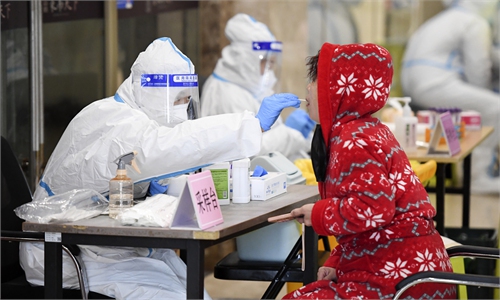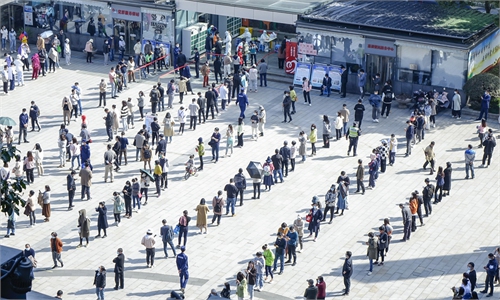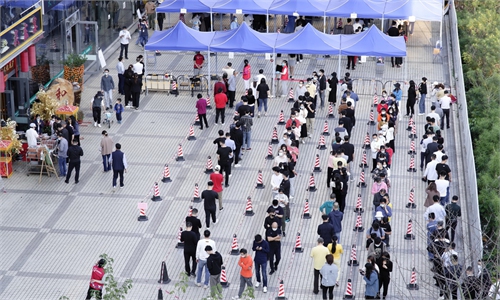China fights severest COVID-19 outbreaks with swift responses
Antigen tests for public use expected to be effective in detecting cases earlier
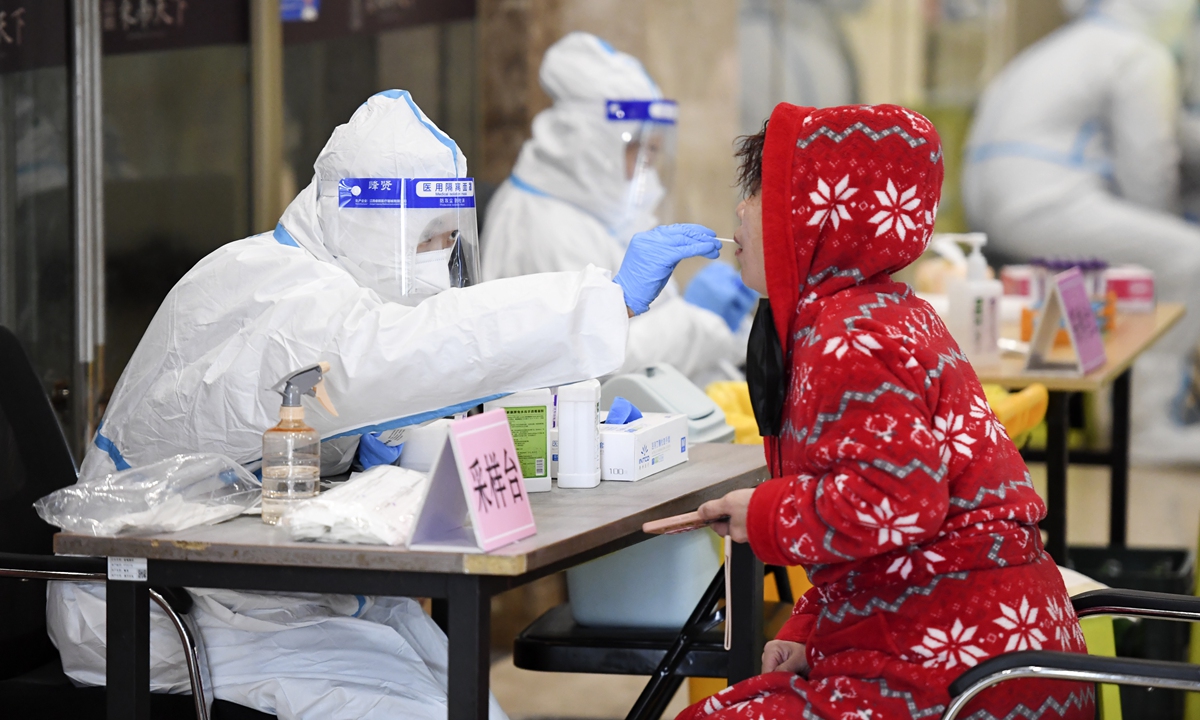
A resident takes the nuceic acid testing in Changchun, Northeast China's Jilin Province on March 13, 2022 as the city has started a new round of citywide testing. Photo: VCG
As China faces its severest domestic COVID-19 outbreaks in two years with a record 1,807 new cases reported on Sunday, the country has launched a swift response to contain the virus spread, including allowing rapid antigen tests for public use and sacking senior officials for their slack response to the ongoing health crisis.
The latest spikes in Northeast China's Jilin, East China's Shandong, South China's Guangdong provinces, Shanghai and Beijing municipalities, which forced several major cities to go into lockdowns, saw a sharp rise in the number of asymptomatic patients. The daily increase in asymptomatic infections exceeded the daily increase in confirmed cases for six consecutive days from March 7 to 12. Meanwhile, the Omicron variant has replaced Delta to become the dominant strain, once again breaching the country's defenses by spreading from campus to community.
However, compared with the situation when the first round of COVID-19 outbreaks, initially reported in Wuhan in February 2020, swept the entire nation, Chinese society has shown greater calm and orderliness toward the latest round of health challenge.
Epidemiologists and observers pointed out that based on the abundant experience China had accumulated in the previous battles and the dynamic zero-COVID policy, which has proven to be effective in curbing severe cases and deaths, it is tougher for the country to win the battle this time, as "victory" not only means the containment of new cases, but also minimizing the impact on the economy and livelihoods.
More concealed
Many local cases have been reported across the nation in the past month. From February 10 to March 13, the number of confirmed domestic cases increased from seven to 1,807, affecting 26 provinces and regions.
One of the hardest hit places is Jilin Province, which registered more than 2,100 positive infections in a day on Saturday, with 1,412 confirmed cases and 744 silent carriers.
At Sunday's press conference, Jilin provincial authorities attributed the significant rise in infections to the highly contagious Omicron variant and the fact that more potential infections were screened out through citywide testing within communities.
The infectivity of the variant that triggered the outbreak was about 30 percent higher than that of the previous variant, and the replication capability was 70 times higher than that of the Delta variant, a local health official said at the press conference.
Jilin's provincial capital, Changchun, has imposed a total lockdown to curb the virus spread, while the city of Jilin, which has the same name as the province and is only 120 kilometers from Changchun, has conducted six rounds of citywide nucleic acid testing.
Another reason is insufficient medical resources in some places in the face of a rapidly rising epidemic situation and defective emergency response of some local governments which failed to test, quarantine, and treat residents as required, Jilin officials said.
The Party chief at a university in Jilin was sacked on Thursday after cluster infections were detected in the campus, which shocked Chinese social media and led to a heated discussion on the school's lack of transparent and effective management.
Furthermore, Wang Lu, the mayor and deputy Party chief of Jilin city, Li Xin, the head of Jiutai district of Changchun, and Gao Yutang, director of the Changchun Health Commission, were also sacked for their slack response to the grave situation.
Jilin provincial Party chief Jing Junhai on Sunday vowed to take firm actions to prevent concealment and delays in reporting.
Authorities of Shenzhen, South China's Guangdong Province, on Sunday decided to put all residential communities under closed management, close stores and business, suspend transportation and launch three rounds of city-wide testing, starting from Monday, as the local COVID-19 epidemic situation continues to worsen.
Also on Sunday, six officials from Dongguan, Guangdong Province were removed from their posts for the defects and loopholes in the daily epidemic prevention tasks at key venues in the city, especially their poor execution of duties which caused cluster infections in Dalang township in late February.
Wang Guangfa, a respiratory expert at Peking University First Hospital who was also one of the experts of the National Health Commission who visited Wuhan in early January 2020, told the Global Times on Sunday that Omicron shows the characteristics of atypical infection symptoms and has a more hidden transmission process, making it difficult to detect infected persons in a timely manner.
Meanwhile, cluster infections in campuses have become a prevalent phenomenon in recent outbreaks. In the city of Laixi, Shandong Province, 304 confirmed cases have been reported since March 4, of whom 217 are students. In this case, the epidemic had already spread insidiously in the school before three students tested positive at a fever clinic. The source of the infection remains unknown.
In addition to Omicron being more likely to infect children, the low inoculation rate among the age group is still a major problem, Wang said.
Wang noted the country's dynamic zero-COVID policy has also been adjusted according to the new situation, citing the newly approved five COVID-19 antigen self-testing products, which will be used as a supplement to the standard nucleic acid testing to help fight the spread of the virus.
Experts said the adjustment was made based on the features of the Omicron variant, which shows that China is adjusting its COVID-19 policy to be more scientific and targeted.
Wang said the products could help detect patients earlier, but more accurate technologies could be adopted. For example, China is studying the use of a type of detection equipment which could be set up in public venues to detect patients through testing aerosols in the air.
A number of pharmaceutical e-commerce platforms have posted messages announcing that self-testing kits for COVID-19 antigen will be sold in stores as of Sunday.
Yang Zhanqiu, a professor of the pathogen biology department at Wuhan University, told the Global Times on Sunday that the severity of the outbreaks is closely linked to the short incubation period of the Omicron variant.
Yang noted that the virus' incubation period was as long as two weeks for some people in the initial outbreak in Wuhan, but the time has now been reduced to two or three days, which has led to more people being infected.
Both Wang and Yang are taking an optimistic attitude to the early arrival of the turning point and the complete control of the outbreaks this time. Due to the short incubation period, infected people can be diagnosed, quarantined and treated in the shortest possible time when they become sick, which in turn reduces the chance of their infecting others.
"If the measures are effective, the country could contain the virus spread in a week and the confirmed cases will be significantly reduced in two weeks. Zero cases can be expected within 28 days," Wang said.
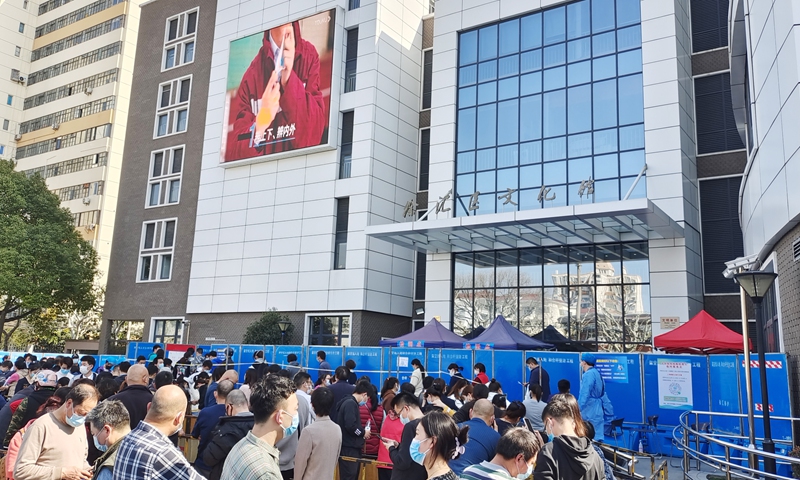
Local Shanghai residents queue up for a nucleic acid test at a cultural center in Xuhui district on March 12, 2022. Photo: VCG
Calmer approach
It seems that the Chinese society is taking a calmer approach toward the latest flare-ups.
Photos and videos circulating online show that life is proceeding in an orderly manner in Changchun, where residents in the city are under closed management.
On Chinese social media, a message left by a delivery man from Shenzhen for the local health commission went viral on Sunday, which touched Chinese netizens' hearts.
"Contactless delivery without having to climb up stairs has been a great convenience for us, but I don't like doing this. I'd rather climb nine floors just to tell my customers 'Enjoy your meal'," he said.
Chinese observers warned local governments to avoid taking extreme measures such as city lockdowns, as they would harm the local economy and people's lives despite having been proven to be effective.
China must strive to achieve a new breakthrough in its dynamic zero-COVID policy. In fighting against the latest outbreaks, if a city can take meticulous, scientific actions to control the spread of the virus and gradually eliminate cases, it can be regarded as a "true hero" of city governance and thus merit being a lesson for the whole country to learn from, they said.
In the face of the resurgence of the epidemic, voices that question China's dynamic zero-COVID policy and advocate "coexistence with the virus" have once again increased.
It's too early to put "coexistence with virus" on the table, as the outbreaks are at a critical phase when thousands of domestically transmitted cases are being registered every day. Behind the current outbreaks is a sign that decisive and strict measures must be adopted to achieve dynamic zero cases in the shortest time, as a large-scale outbreak may once again occur, an immunologist told the Global Times on condition of anonymity.
The expert believed that openness is a future direction and trend, but as for when and how this is achieved is a question which may require different approaches.


